As we have discussed in several previous StreetWise columns, the distressed asset pipeline, which has been clogged for nearly two years, is beginning to loosen up. Lenders and special servicers are faced with thousands of distressed assets on their balance sheets and in their portfolios, yet until recently, only a small number of these assets have made their way to the market.
Everything that has happened from a regulatory perspective has provided these entities with the ability to avoid having to make decisions relative to these distressed assets. These regulatory changes have included changes in the FASB market-to-market accounting rules, modifications to REMIC guidelines and bank regulators letting banks hold notes on their books at par even though they know the collateral is worth substantially less.
The Federal Reserve's highly accommodative monetary policy is allowing for the recapitalization of the banking industry which is relieving pressure on lenders to deal with distressed assets quickly.
Additionally, the foreclosure process can be particularly long, cumbersome and complicated (particularly in states other than Texas and Georgia). Many holders of distressed assets are choosing to sell notes rather than wait for the foreclosure process to be completed which would allow them to sell the assets rather than the paper.
Note sales can take two forms. The first is simply a financial transaction in which a bank or special servicer will pool many disparate loans with disparate collateral spread throughout a state, region or the entire country. These loans will typically be sold to what we call a "financial engineer" which will look at each loan, determine where it is in the foreclosure process, what can be done to enhance the note's value and how to maximize the value of the individual loans for resale. These buyers are simply buying on a percentage-of-par basis and are looking to make a profit on the slicing and dicing of these pools.
The other approach to note sales is to simply sell a single note, collateralized by a property or a portfolio of properties. The typical buyer here will be a real estate investor who is buying the paper to get to the title of the property and own the assets on a long-term basis. These buyers typically pay much more for the note than a financial engineer will because they don't have to build a profit into the process of administrating the foreclosure process. This is the type of note sale transaction that Massey Knakal has focused on in our Special Assets Group.
If we look at the distressed assets that we have sold recently and are currently working on, 78 percent of them have been note sales as opposed to REO ("Real Estate Owned" is a typical term used by lenders for properties they take title to after a foreclosure) sales. We expect this percentage to decline as time goes on and the foreclosure process is allowed to finish. Our large percentage of note sales versus REO sales is not surprising when consideration is given to the percentage of recovery sellers are achieving on note sales relative to collateral value.
Collateral value is the key measuring stick by which we determine how effective a note sale recovery can be. I am often called by investors who claim that they want to buy distressed notes, however as soon as they tell me that they wish to buy paper at 50 cents on the dollar, meaning 50 percent of par value, I immediately know that they are not serious note buyers and let them know that they will be unsuccessful in this endeavor. .
The reason I say this is because if the collateral value is only 40 percent of par, they will be overpaying at 50 percent and will lose money. If, however, the collateral is worth 90 percent of par, and they are only offering 50 percent, they are not going to be able to buy anything as savvy investors will certainly outbid them. Therefore, we see that par value is really irrelevant relative to what a recovery will be.
A much more important indicator is collateral value or what the asset is worth if the deed were to be delivered. When we are retained by an institution to sell a note, the first thing we do is calculate the value of the collateral. This amount is then discounted by a percentage which is derived based upon taking the entire scenario into consideration. The variables include how far along the institution is in the foreclosure process, whether the borrower is being cooperative and the quality of the documentation.
Clearly, if a foreclosure process is nearing its conclusion, it is a very different situation than if the foreclosure process has not even begun but the note is in default. Similarly, if a borrower is cooperative, it adds value to the recovery. We have done transactions in which the borrower had a completely adversarial relationship with the lender, such that we could not even gain access to the property. In cases like that, we may not even be aware of the the tenancy in the property. In a scenario like that, the discount for the note would be much more significant than if the borrower is cooperative and we have a sense of how the real estate is performing.
Additionally, it is important to do significant due diligence on the quality of the documentation that exists. All documents must be reviewed including the note, the mortgage and the intercreditor agreements (to the extent that there is subordinate debt on the property). A summary of all interaction between the borrower and the lender can also be helpful.
When marketing a note, we move down two parallel paths simultaneously in that we must not only perform due diligence on the real estate asset, we must perform due diligence on the documentation to fully understand what exactly it is we are selling. This takes tremendous amount of time and effort but is important to make sure that all participants in the transaction fully understand what they are stepping into.
Another factor which greatly affects the recovery on a note sale is the extent to which the seller of the note is prepared to make representations. Some lenders have very complete files and are willing to make substantial representations about what they have and what they have done. Here , recovery is enhanced.
There are, however, some lenders that will only represent that they own the note and have authorization to sell the note. They will not make any representations beyond this. I am often asked by a lender or a special servicer if a note can be sold under those circumstances. My answer is always that everything can be sold and everything has a price; it is only a question of what the highest price will be. Understandably, the more definitive the representations a lender is willing to make, the higher the final price and, therefore, the recovery.
Note sales have been dominating the distressed asset market recently and are becoming more and more popular. This is particularly true as distressed asset holders attempt to take advantage of the supply / demand imbalance that I often refer to in this column which provides the seller the ability to achieve pricing higher than what current economic fundamentals would dictate. There is significantly more demand than there is supply which is resulting in dozens of investors competing for each availability.
Under these circumstances, there is no wonder why distressed asset holders are eagerly entering the note sale market.
Mr. Knakal is the Chairman and Founding Partner of Massey Knakal Realty Services in New York City and has brokered the sale of over 1,050 properties in his career having an aggregate market value in excess of $6.2 billion.
© Touchpoint Markets, All Rights Reserved. Request academic re-use from www.copyright.com. All other uses, submit a request to [email protected]. For more inforrmation visit Asset & Logo Licensing.






